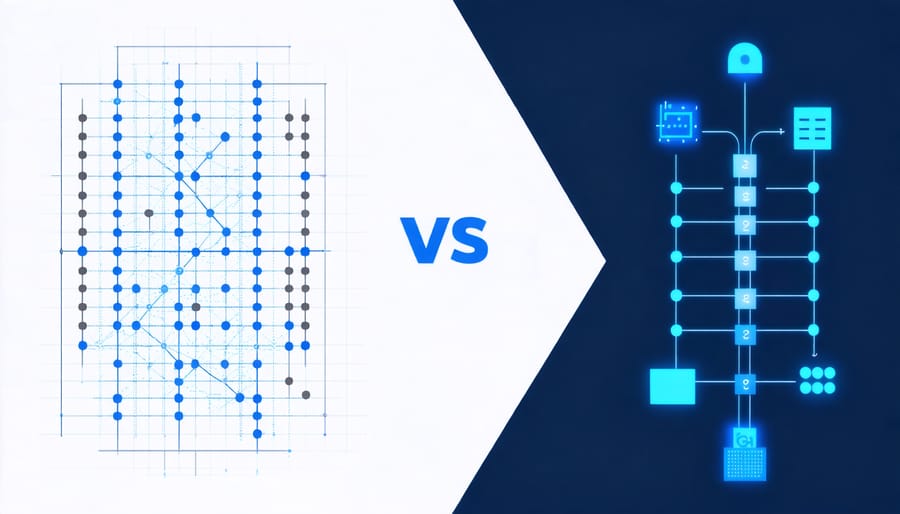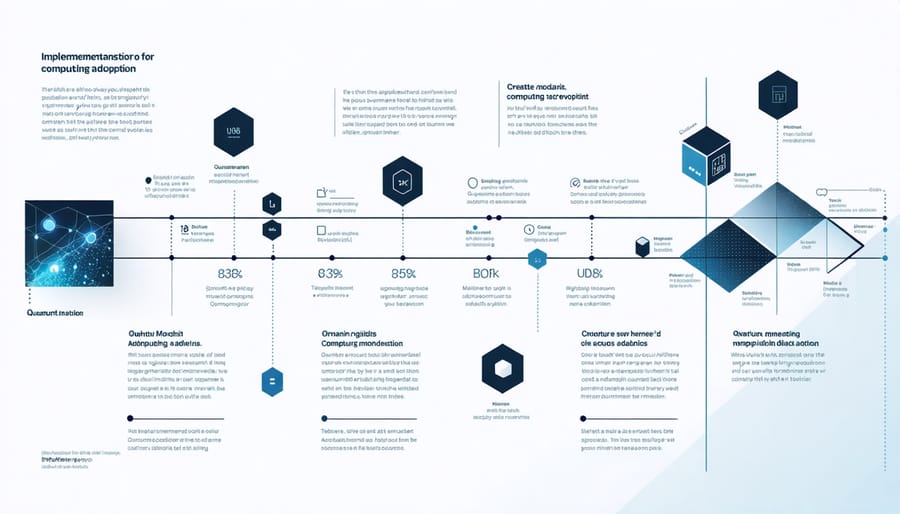How Quantum Computing Is Transforming B2B Data Analysis Today

Quantum computing revolutionizes business analytics by solving complex optimization problems in seconds that would take traditional computers years to process. Major corporations like IBM, Google, and Microsoft are already leveraging quantum algorithms to transform supply chain management, financial modeling, and risk analysis. Through quantum-powered data processing, businesses can now analyze millions of market scenarios simultaneously, optimize delivery routes across global networks, and predict market trends with unprecedented accuracy. This breakthrough technology enables organizations to tackle previously impossible computational challenges, offering a competitive edge in today’s data-driven marketplace. As quantum computers become more accessible, forward-thinking businesses are exploring practical applications in cybersecurity, drug discovery, and artificial intelligence – creating new opportunities for innovation and growth. Understanding these real-world examples helps decision-makers identify how quantum computing can deliver tangible benefits to their operations, particularly in areas requiring complex calculations and pattern recognition.
The Power of Quantum Analysis in Modern Business
From Classical to Quantum: A Business Perspective
Traditional computing relies on binary systems – yes or no, 1 or 0 – much like a light switch that’s either on or off. Quantum computing introduces a revolutionary approach where bits can exist in multiple states simultaneously, similar to having a dimmer switch with infinite settings. For businesses, this translates to solving complex problems exponentially faster than classical computers.
Consider a delivery company optimizing routes across 100 cities. While a classical computer would need to calculate each possible route individually, a quantum computer can analyze multiple possibilities simultaneously. This capability means tasks that would take traditional computers years to complete can potentially be solved in minutes or hours.
This quantum advantage becomes particularly valuable in areas like financial modeling, supply chain optimization, and customer behavior analysis, where businesses need to process vast amounts of data and consider multiple variables simultaneously.

Real-World Applications in B2B Markets
Leading financial institutions like JPMorgan Chase and Goldman Sachs are already leveraging quantum computing for portfolio optimization and risk analysis. Manufacturing giants such as Volkswagen use quantum algorithms to optimize supply chain logistics and production schedules, reducing operational costs by up to 30%.
In the pharmaceutical sector, companies like Merck are accelerating drug discovery processes through quantum simulations of molecular interactions. This has cut research timelines from years to months. IBM’s quantum computing services help businesses solve complex optimization problems, from delivery route planning to inventory management.
Energy companies including BP and Shell utilize quantum computing for seismic data analysis and carbon capture optimization. These applications have improved drilling accuracy and environmental impact assessments. Additionally, telecommunications providers are implementing quantum-secure networks to protect sensitive B2B communications from future cyber threats.
These real-world applications demonstrate how quantum computing is transforming traditional business operations across industries, offering tangible competitive advantages to early adopters.
Practical Examples of Quantum Computing in Action
Supply Chain Optimization
Supply chain optimization represents one of the most promising applications of quantum computing in business operations. By processing complex logistics data exponentially faster than traditional computers, quantum systems can revolutionize how companies manage their supply chains. This technology, when combined with IoT data analysis, enables businesses to optimize delivery routes, inventory management, and warehouse operations in real-time.
For instance, a retailer with thousands of products across multiple warehouses can use quantum computing to calculate optimal inventory levels while considering numerous variables simultaneously. These variables include seasonal demand fluctuations, transportation costs, storage capacity, and supplier lead times. Traditional computers might take days or weeks to process these calculations, while quantum computers can deliver results in minutes.
The technology also excels at solving the “traveling salesman problem” – determining the most efficient delivery routes when multiple destinations are involved. This capability helps businesses reduce fuel costs, minimize delivery times, and improve customer satisfaction. Companies implementing quantum-powered supply chain solutions have reported up to 30% reduction in logistics costs and 25% improvement in delivery efficiency.
Moreover, quantum computing enables more accurate demand forecasting by analyzing vast amounts of historical data and market trends. This helps businesses maintain optimal inventory levels, reduce warehousing costs, and minimize waste from overstocking or stockouts.

Risk Analysis and Financial Modeling
Quantum computing is revolutionizing risk analysis and financial modeling in ways previously thought impossible. Financial institutions are leveraging quantum algorithms to optimize investment portfolios, predict market fluctuations, and assess risk factors with unprecedented accuracy. Similar to how blockchain technology in B2B transformed transaction security, quantum computing is reshaping financial decision-making.
Major banks are already implementing quantum-powered Monte Carlo simulations, enabling them to analyze thousands of market scenarios simultaneously. This capability allows for more accurate pricing of complex financial instruments and better risk assessment in real-time. For instance, JPMorgan Chase has successfully used quantum computing to optimize trading strategies and improve fraud detection systems.
The technology’s impact on options pricing and derivatives trading is particularly noteworthy. Traditional computers might take hours or days to calculate complex risk metrics, while quantum systems can deliver results in minutes. This speed advantage translates into better investment decisions and more effective risk management strategies.
For smaller financial institutions, quantum computing services are becoming increasingly accessible through cloud platforms. This democratization means businesses of all sizes can benefit from enhanced portfolio optimization, improved risk assessment, and more accurate financial forecasting without significant infrastructure investments.
Customer Behavior Pattern Recognition
Quantum computing is revolutionizing how businesses understand and predict customer behavior patterns. By processing vast amounts of customer data simultaneously, quantum algorithms can identify complex relationships and patterns that traditional computing methods might miss. This advanced processing power enhances predictive analytics capabilities, allowing businesses to forecast customer preferences and buying behaviors with unprecedented accuracy.
For example, retail businesses can analyze shopping patterns across multiple channels, considering factors like seasonal trends, demographic information, and economic indicators simultaneously. This comprehensive analysis helps create more personalized marketing strategies and improve inventory management. Financial institutions use quantum computing to detect subtle patterns in transaction data, enabling better fraud detection and customer service optimization.
The technology also excels at processing unstructured data from social media interactions, customer service calls, and online reviews. By identifying emotional patterns and sentiment trends, businesses can proactively address customer needs and adjust their service delivery. This real-time pattern recognition enables companies to make data-driven decisions quickly, leading to improved customer satisfaction and retention rates.
The practical impact is significant: businesses using quantum-powered customer analysis report up to 30% improvement in customer retention and a 25% increase in marketing campaign effectiveness. These results demonstrate how quantum computing is transforming customer behavior analysis from a reactive to a proactive business function.
Implementation Considerations for Businesses
Cost-Benefit Analysis
Implementing quantum computing solutions requires careful consideration of both financial investments and potential returns. Initial costs typically include hardware acquisition, infrastructure setup, and specialized personnel training, ranging from $100,000 to several million dollars depending on the scale of implementation.
The primary expenses involve:
– Hardware procurement and maintenance
– Specialized software licenses
– Expert quantum computing personnel
– Training programs for existing staff
– Infrastructure modifications
– Cooling systems and power requirements
However, the benefits can significantly outweigh these costs for organizations dealing with complex computational problems. Companies report 20-30% efficiency improvements in optimization scenarios, while financial institutions have seen up to 40% faster processing times for risk analysis calculations.
Return on investment typically manifests in:
– Reduced time-to-solution for complex problems
– Lower operational costs through optimized processes
– Competitive advantage in data-intensive industries
– Enhanced capability to handle larger datasets
– Improved accuracy in predictive modeling
– Energy savings through efficient calculations
Most organizations achieve break-even within 2-3 years of implementation, with some reporting positive ROI in as little as 18 months. The key to maximizing returns lies in selecting specific use cases where quantum advantage clearly surpasses classical computing solutions. Organizations should start with pilot programs in non-critical areas to validate benefits before scaling up investment.

Getting Started with Quantum Solutions
Getting started with quantum computing for data analysis doesn’t have to be overwhelming. Begin by identifying specific business problems that could benefit from quantum solutions, such as optimization challenges or complex calculations that traditional computers struggle with.
First, assess your current data infrastructure and determine where quantum computing can add value. Many businesses start with hybrid approaches, combining classical and quantum methods. Cloud-based quantum computing services from major providers offer accessible entry points without significant hardware investments.
Consider these practical steps for implementation:
1. Partner with quantum computing service providers who offer business-focused solutions
2. Train your team on quantum basics and relevant applications
3. Start with small-scale pilot projects to demonstrate value
4. Develop clear metrics to measure success and ROI
5. Build a roadmap for scaling quantum solutions
Begin with quantum-inspired algorithms, which can run on classical computers while providing insights into quantum approaches. These serve as an excellent stepping stone to full quantum implementation.
Remember to focus on business outcomes rather than getting caught up in the technology itself. Start with well-defined problems where quantum computing has proven advantages, such as portfolio optimization or supply chain logistics.
Regular assessment and adjustment of your quantum strategy ensure alignment with business objectives while maximizing return on investment. Consider working with quantum computing consultants who can guide your implementation process and help avoid common pitfalls.
Quantum computing stands poised to revolutionize B2B data analysis by offering unprecedented processing capabilities and insights. As businesses continue to generate massive amounts of data, quantum computers will enable real-time analysis of complex datasets, leading to more accurate predictions and better decision-making. The technology’s ability to simultaneously process multiple data states will transform everything from supply chain optimization to customer behavior analysis. While widespread adoption may still be years away, forward-thinking businesses are already exploring quantum computing solutions through partnerships with tech providers and research institutions. Organizations that begin preparing for this quantum shift today will gain a significant competitive advantage in the data-driven future of B2B operations. The impact on efficiency, cost reduction, and innovation potential makes quantum computing not just a technological advancement, but a fundamental business imperative for the decades ahead.
Leave a Reply